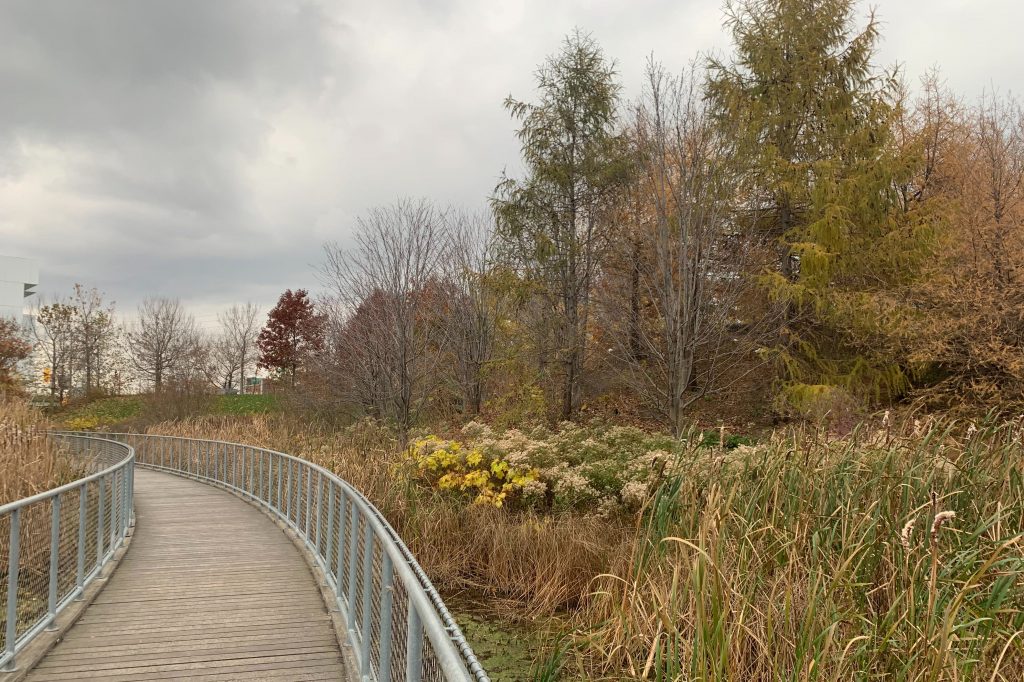
Last month, I walked around Liberty Village, another neighbourhood that was built around old industrial buildings and blocked off from traffic on at least two sides. I wasn’t happy, especially with the haphazard planning and the ugly, dehumanizing condos cramped near Strachan.
Corktown, located on the other side of the city, is the complete opposite. There’s a genuine sense of neighbourhood here, with lots of interesting public spaces, a good mix of shops and restaurants integrated with new condo developments and better access to public transportation. I hope recent developments don’t change the vibe.

Start: Sunday, 2:45 pm, Cube House, 1 Sumach
I figured I would begin at one of Corktown’s most famous landmarks, the Cube House, built in the 1990s by Canadian architect Ben Kutner, who modelled it after Dutch architect Piet Blom’s cube houses in Rotterdam. Kutner intended it as an affordable housing solution in otherwise unusable areas of land. It’s still striking, especially if you’re taking the nearby ramp onto or off the Don Valley Parkway. But alas, it may soon be gone, to be replaced by new development.
The same fate could also befall the nearby Dominion Wheel and Foundries Company, which is still plastered with Save the Foundry signs from protests after the site was sold by the city to a developer. If these two landmarks are razed, it will greatly affect the feel of the neighbourhood.
What is there to do and see?
One of the nice things about Corktown (whose name comes from the fact that many original residents came from Cork, Ireland) is that its streets aren’t on a grid. They sort of wind around each other. And meanwhile, nearby are raised ramps leading on and off highways. Rather than feel dangerous and precarious, however (who wants to be under a loud, busy concrete off ramp?), the area here has been imaginatively repurposed.

The Underpass Park features bold sculpture, a kids’ playground and hosts a farmer’s market. A little further east is the Underpass Skate Park, which includes a separate basketball area and everything a skater could want: rails, banks, ledges, pads. When I pass by, admiring the graffiti (way more interesting, IMO, than the work at Queen West’s Graffiti Alley), the park is being used by dozens of skateboarders. (This area is like a grittier, cooler version of the Bentway.)
After this, I walk among the recent condo developments. The buildings are spaced apart, and a few of them are works of art themselves. 21 Lawren Harris Square features a great big shiny aluminum-looking wedge at the base that’s like a piece of modern sculpture; 35 Lawren Harris Square (the front entrance is at 170 Bayview), meanwhile, looks different from every angle. One side features balconies and windows that jut out dramatically over what looks like a concrete cube base (a nod to the nearby Cube House?), while another plays fascinatingly with contrasting black and white.

From here’s it’s a short walk to Corktown Common, which I covered in one of my first Pandemic Walks. Built on former unused industrial land, it’s a marvel of efficiency and design. A few minutes from your residence you can be among bullrushes and marshy areas, enjoying the wildlife it attracts.
You can picnic with friends or even play a ball game on the pitch. There’s a big splash pad and playground for kids. And there’s a dog run area on a hill just east of the common that resembles something natural, and not one of those dusty, muddy dog parks you find elsewhere. Alas, the public washrooms are closed for winter, even though winter doesn’t officially arrive until another few weeks.

Front St Promenade
Just west of the Common is a well-designed public area called the Front St. Promenade. It’s full of public art, including Jennifer Marman and Daniel Borins’s playful sculpture/landscape design/play project, The Water Guardians, features lots of benches and makes the area feel airy, open and fun. At ground level there’s everything from a little rock-climbing place to cafes and brew pubs. Above them, all of the residential buildings look different and aren’t higher than 11 or 12 storeys. The mix of residential and commercial activity feels humanly scaled.
Although Corktown is blocked to the south by the GO Transit train yard, it doesn’t feel cramped or claustrophobic. Mark di Suvero’s metal sculpture called No Shoes adds dramatic height, colour and interest to a corner that could have simply looked depressing.

If you head north, there are other marvellous sights, like the Enoch Turner Schoolhouse, the city’s first free school, little blocks of quaint Victorian row houses and the very swank Gusto 501 restaurant. A new bike shop called Gears at King and Lower River feels perfectly integrated into the neighbourhood. And if you buy a bike there, the Lower Don River Trail is only a few minutes away.
End: 3:40 pm, King and Lower River
Until I started my Pandemic Walk series and found the Corktown Common, I had no idea this neighbourhood even existed. In fact, standing at King and Lower River looking south, you wouldn’t know there was much to see and do. Which gives it an intimacy I hope doesn’t change as more development crops up around it.
See more Toronto walks here












